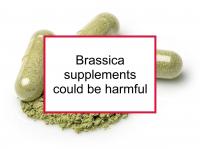A new review of available research has reported that isothiocyanates may damage the DNA of normal cells at doses obtainable through the use of broccoli extracts, sulforaphane supplements, and other concentrated sources. Isothiocyanates are found primarily in cruciferous vegetables.
Isothiocyanates have been found to have chemopreventive activities against chronic degenerative conditions such as cancer, diabetes, and cardiovascular and neurodegenerative diseases. Modification of proteins has been demonstrated to be an important mechanism underlying the biological activity of isothiocyanates.
The nuclear factor-erythroid-2-related factor 2 system, which regulates the expression of a wide variety of antioxidant genes, has a role in the effect of isothiocyanates against almost all of the above diseases. Recent evidence concerning inflammation, which promotes many diseases, suggests another possible mechanism of action of isothiocyanates. Isothiocyanates have been shown to inhibit the activity of certain inflammation components, as well as suppressing cyclooxygenase 2, and irreversibly inactivating the macrophage migration inhibitory factor.
However, some isothiocyanates can form adducts with DNA and induce gene mutations and chromosomal aberrations. DNA adducts form when DNA bonds to a chemical mutagen. The binding of reactive carcinogens to DNA is considered the initiating event in chemical carcinogenesis. In fact, the dose-response relationship for genotoxic compounds typically does not suggest evidence of a threshold below which no damage occurs. Therefore, the potential genotoxicity of isothiocyanates should be carefully evaluated and taken into account when considering the benefits of isothiocyanate consumption.
Levels of isothiocyanates obtained through the diet appear to be several orders of magnitude lower than the doses used in genotoxicity studies. Therefore, it is unlikely that meaningful DNA damage would occur in humans as a result of consumption of isothiocyanate-rich foods. However, the reported beneficial properties of isothiocyanates have prompted increased of use of dietary supplements and functional foods with highly enriched isothiocyanate concentrations.
The authors conclude that the possibility that such enriched isothiocyanate sources may exert a potential health risk cannot be excluded with certainty. An accurate evaluation of the toxicological profile of isothiocyanates should be prompted before any major increase in their consumption be recommended or their clinical use suggested.
